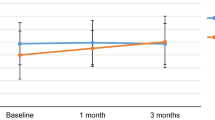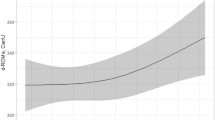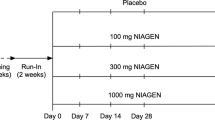Abstract
Objective: High-dose vitamin C therapy might mediate beneficial clinical effects by counteracting reactive oxygen species. However, concerns are raised whether this approach might provoke diametrical (ie pro-oxidative) effects. The objective was to determine ascorbyl free radical (AFR) concentrations and potential variables of pro-oxidative damage.
Design: Crossover study; six healthy males received daily infusions of 750 or 7500 mg vitamin C for six consecutive days. Fasting concentrations of vitamin C and AFR were determined daily. On day 1, concentrations of vitamin C and AFR were measured at 0.25, 0.5, 1, 2, 4 and 8 h post infusion. Plasma concentrations of thiobarbituric acid-reactive substances (TBARS), tocopherol and urine concentrations of 8-oxoguanosine were determined on days 1 and 6.
Results: Kinetic studies on day 1 showed that concentrations of vitamin C and AFR displayed parallel dose- and time-dependent kinetics and elimination was highly efficient. Vitamin C and AFR fasting concentrations on days 2–6 were slightly above the baseline, suggesting new, stable steady states. TBARS decreased in both groups, whereas tocopherol and 8-oxoguanosine concentrations remained unchanged.
Conclusion: Kinetics of AFR largely depend on plasma vitamin C concentrations and AFR is eliminated efficiently. Our data do not support induction of pro-oxidative effects in healthy volunteers given intravenous high-dose vitamin C.
Sponsorship: Pascoe Pharmazeutische Präparate GmbH, Gießen, Germany.
This is a preview of subscription content, access via your institution
Access options
Subscribe to this journal
Receive 12 print issues and online access
$259.00 per year
only $21.58 per issue
Buy this article
- Purchase on Springer Link
- Instant access to full article PDF
Prices may be subject to local taxes which are calculated during checkout






Similar content being viewed by others
References
Bates CJ (1992): Use of homocystein to stabilise ascorbic acid, or to reduce dehydroascorbic acid, during HPLC separation of large volumes of tissue extracts. Clin. Chim. Acta. 205, 249–252.
Bergsten P, Amitai G, Kehrl J, Dhanwal KR, Klein HG & Levine M (1990): Millimolar concentrations of ascorbic acid in purified human mononuclear leukocytes. Depletion and reaccumulation. Biochem. J. 265, 2584–2587.
Bergsten P, Yu R, Kehrl J & Levine M (1995): Ascorbic acid transport and distribution in human B lymphocytes. Arch. Biochem. Biophys. 317, 208–214.
Bianchi J & Rose RC (1986): Dehydroascorbic acid and cell membranes: possible disruptive effects. Toxicology 40, 75–82.
Biesalski HK, Greiff H, Brodda K, Hanfer G & Bässler KH (1986): Rapid determination of vitamin A (retinol) and vitamin E (á-tocopherol) in human serum by isocratic adsorption HPLC. Int. J. Nutr. Res. 56, 319–327.
Cai L, Koropatnick J & Cherian MG (2001): Roles of vitamin C in radiation-induced DNA -damage in presence and absence of copper. Chem. Biol. Interact. 137, 75–88.
Ellis GR, Anderson RA, Chirkov YY, Morris-Thurgood J, Jackson SK, Lewis MJ & Frenneaux MP (2001): Acute effects of vitamin C on platelet responsiveness to nitric oxide donors and endothelial function in patients with chronic heart failure. J. Cardiovasc. Pharmacol. 37, 564–570.
Galley HF, Davies MJ & Webster NR (1996): Ascorbyl radical formation in patients with sepsis: effect of ascorbate loading. Free Radic. Biol. Med. 20, 139–143.
Goldenberg H, Grebing C & Low H (1983): NADH-monodehydroascorbate reductase in human erythrocyte membranes. Biochem. Int. 6, 1–9.
Graumlich JF, Ludden TM, Conry-Cantilena C, Cantilena LR, Yaohui Jr W & Levine M (1997): Pharmacokinetic model of ascorbic acid in healthy volunteers during depletion and repletion. Pharmacol. Res. 14, 1133–1139.
Guidarelli A, De Sanctis R, Cellini B, Fiorani M, Dacha M & Cantoni O (2001): Intracellular ascorbic acid enhances the DNA single-strand breakage and toxicity induced by peroxynitrite in U937 cells. Biochem. J. 365, 509–513.
Heitzer T, Schlinzig T, Krohn K, Meinertz T & Munzel T (2001): Endothelial dysfunction, oxidative stress, and risk of cardiovascular events in patients with coronary artery disease. Circulation 104, 2673–2678.
Jentzsch AM, Bachmann H, Fürst P & Biesalski HK (1996): Improved analysis of malondialdehyd in human body fluids. Free Radic. Biol. Med. 20, 251–256.
Jones B & Kenward MG (1989): Design and Analysis of Cross-Over Trials. London: Chapman and Hall. pp 51–59.
Lee SH, Oe T & Blair IA (2001): Vitamin C-induced decomposition of lipid hydro- peroxides to endogenous genotoxins. Science 292, 2083–2086.
Levine M, Conry-Cantilena C, Yaohui Wang J, Welch RW, Washko PW, Dhariwal KR, Park JB, Lazarev A, Graumlich JF, King J & Cantilena LR (1996): Vitamin C pharmacokinetics in healthy volunteers: evidence for a recommended dietary allowance. Proc. Natl. Acad. Sci. USA 93, 3704–3709.
Levine M, Wang Y, Padayatty SJ & Morrow J (2001): A new recommended dietary allowance of vitamin C for healthy young women. Proc. Natl. Acad. Sci. USA 98, 9842–9846.
Loft S, Vistisen K, Ewertz M, Tjonneland A, Overvad K & Poulsen HE (1992): Oxidative DNA damage estimated by 8-hydroxydeoxyguanosine excretion in humans: influence of smoking, gender, and body mass index. Carcinogenesis. 13, 2241–2247.
May JM, Qu Z, Morrow JD & Cobb CE (2000): Ascorbate-dependent protection of human erythrocytes against oxidant stress generated by extracellular diazobenzene sulfonate. Biochem. Pharmacol. 60, 47–53.
May JM, Qu Z & Cobb CE (2001): Recycling of the ascorbate free radical by human erythrocyte membranes. Free Radic. Biol. Med. 31, 117–124.
Pence LA & Mennear JH (1979): Inhibition effect of dehydroascorbic acid on insulin secretion from mouse pancreatic islets. Toxicol. Appl. Pharmacol. 50, 57–65.
Podmore ID, Griffith HR, Karl HE, Mistry N, Mistry P & Lunec J (1998): Vitamin C exhibits pro-oxidant properties. Nature 392, 559–560.
Priem H, Loft S, Nyyssönen K, Salonen JT & Poulsen H (1997): No effect of supplementation with vitamin E, ascorbic acid, or coenzyme Q10 on oxidative DNA damage estimated by 8-oxo-7,8-dihydro-2′-deoxyguanosin excretion in smokers. Am. J. Clin. Nutr. 65, 503–507.
Rose RC, Choi JL & Bode AM (1992): Short term effects of oxidized ascorbic acid on bovine corneal endothelium and human placenta. Life Sci. 50, 1543–1549.
Schneider M, Diemer K, Engelhart K, Zankel H, Trommer WE & Biesalski HK (2001): Protective effects of vitamin C and E on the number of micronuclei in lymphocytes in smokers and their role in ascorbate free radical formation in plasma. Free Radic. Res. 34, 209–219.
Tanaka H, Matsuda T, Miyagantani Y, Yukioka T, Matsuda H & Shimazaki S (2000): Reduction of resuscitation fluid volumes in severely burned patients using ascorbic acid administration: a randomized, prospective study. Arch. Surg. 135, 326–331.
Van Duijn MM, Karmi T, Van Steveninck J, Van den Broek PAJ & Van der Zee J (2000): Erythrocytes reduce extracellular ascorbate free radicals using intracellular ascorbate as an electron Donor. J. Biol. Chem. 275, 27720–27725.
Villalba JM, Canalejo A, Rodriguez-Aguilera JC, Buron MI, Morre DJ & Navas P (1993): NADH-ascorbate free radical and -ferricyanide reductase activities represent different levels of plasma membrane electron transport. J. Bioenerg. Biomembr. 25, 411–417.
Washko PW, Rotrosen D & Levine M (1989): Ascorbic acid transport and accumulation in human neutrophils. J. Biol. Chem. 264, 18996–19002.
Welch RW, Bergsten P, Butler JD & Levine M (1993): Ascorbic acid accumulation and transport in human fibroblasts. Biochem. J. 294, 505–510, 1993.
Wenzel HR, Pfleiderer G, Trommer WE, Paschenda K & Redhardt A (1976): The sythesis of spin-label derivatives of NAD+ and its structural components and their binding to lactate dehydrogenase. Biochem. Biophys. Acta. 452, 292–301.
Williams MJ, Sutherland WH, McCormick MP, de Jong SA, McDonald JR & Walker RJ (2001): Vitamin C improves endothelial dysfunction in renal allograft recipients. Nephrol. Dial. Transplant. 16, 1251–1255.
Acknowledgements
This study was supported by Pascoe Pharmazeutische Präparate GmbH, Gießen, Germany. Data were presented at Nutrition Week 2002 in San Diego, CA and published in abstract form in Am. J. Clin. Nutr. 75: 2(S) A228 abstr (2002).
Author information
Authors and Affiliations
Contributions
Guarantor: HK Biesalski.
Contributors: Andreas Mühlhöfer: conception, conduct of the clinical experiment, interpretation of data, writing; Silke Mrosek: conduct and organization of the clinical experiment, measurement of variables such as vitamin C, TBARS, vitamin E, interpretation of data; this work is part of her diploma thesis; Beate Schlegel: conduct and organization of the clinical experiment, interpretation of data, writing; Wolfgang Trommer, Fabio Rozario: measurement of AFR; Hansjosef Böhles: measurement of 8-oxoguanosin; Dieter Schremmer: statistical analysis; Wolfram G. Zoller: conduct and organization of the clinical experiment, interpretation of data; Hans K. Biesalski: conception, design of the clinical experiment, interpretation of data, writing; funding by Pharmaforschungs GmbH, Gieβen.
Corresponding author
Rights and permissions
About this article
Cite this article
Mühlhöfer, A., Mrosek, S., Schlegel, B. et al. High-dose intravenous vitamin C is not associated with an increase of pro-oxidative biomarkers. Eur J Clin Nutr 58, 1151–1158 (2004). https://doi.org/10.1038/sj.ejcn.1601943
Received:
Revised:
Accepted:
Published:
Issue Date:
DOI: https://doi.org/10.1038/sj.ejcn.1601943
Keywords
This article is cited by
-
High-Dose Intravenous Ascorbic Acid: Ready for Prime Time in Traumatic Brain Injury?
Neurocritical Care (2020)
-
There’s life in the old dog yet: vitamin C as a therapeutic option in endothelial dysfunction
Critical Care (2014)



